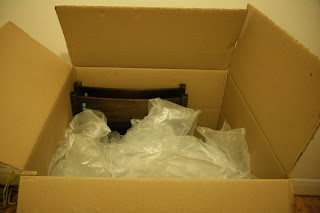Green Deal Basics
As detailed in a blog post last year, my home energy use and a thermal imaging survey I had done show very clearly that my house is in need of serious energy efficiency work. I was intending to do this last year but working out how to finance the work proved to be a bit of a problem as I had depleted my savings to minimise the size of the mortgage. So when the Green Deal came along, I thought it would be the ideal opportunity to get the work done.
The way the Green Deal work is meant to be extremely simple:
- Get an assessment done via an accredited Green Deal Assessor,
- Find a Green Deal Provider,
- Get the work done via a the provider and a Green Deal Installer,
- Pay back the money via your electricity bill.
As an aside on the last step, considering that the Green Deal is meant to improve energy efficiency and that most of the housing stock in the UK suffers from poor insulation, the energy use that is most likely to be affected is heating, which in turn would primarily affect gas bills. Therefore paying back via your electricity bill sounds slightly counter-intuitive.
As another aside on the last step, you pay back the money with interest (you didn't think it'd be free credit, did you?) and the interest rate on Green Deal loans is around 7.5% as explained by Which? in their guide. This is not a great rate and you may have cheaper options at your disposal, as explained by Which? as you can choose to finance the works differently. The main advantage of Green Deal loans compared to any other option is that they are attached to the property rather than yourself. The way I understand it, it means that if you sell the property, the next owners will repay the remainder of the loan on their electricity bill as they benefit from the improvements and the loan will not be subject to any credit checks against you. However, don't take my word as gospel, check with an accredited adviser, which brings me to the next step.
Finding an Assessor
The first step in the Green Deal is to find an assessor. The best way to do this is to peruse the search facility on the Green Deal Oversight & Registration Body's web site: you can search by name or postcode, residential, non-residential or both. If you search by postcode, results will be ordered based on proximity, which is very handy.
I did just that and am going down the list, calling each one of them in turn based on the assumption that I will get a much better feel for the company if I have them on the phone than if fill in an online form. I added a small tweak to this, I will not call British Gas for two reasons: I called them last year so I know what their offering is like and will actually use them as a benchmark to compare the other guys against, and I am all for giving my money to smaller businesses rather than large incumbents. So far I called five of them and got fairly varied answers, little of it being promising.
- When I called the first company, I got to speak to a nice lady who had an accent that was quite hard to understand. She understood what I was looking for but failed to adequately answer my questions. In particular when I asked her how they could justify charging me £150 for an assessment when British Gas was charging £99, she told me that they would not require me to go forward with them as a Provider, contrary to British Gas that would. This sounded a bit off as I seemed to remember there wasn't any condition to the British Gas assessment. Anyway, the whole conversation felt a bit dodgy and she completely failed to take any of my details or to tell me how to organise an assessment with them. In fact, I positively had the impression she wanted me off the phone.
- The second company was a bit more promising as the lady I spoke to knew what I wanted and said that I had to fill in their online survey and that someone would call me back. I felt that their survey was more geared towards working out how much cashback I could get on the deal than actually taking meaningful information from me but I filled it in nonetheless. Nobody has called back yet. Note that even though the cashback option is nice, this is not the primary reason I want to go through the Green Deal so I'm not sensitive to any advertising that focuses on that. Others may be.
- The third company I called was the first one that is a generic green energy company and that does not focus solely on the Green Deal. To the point that not only does their web site fail to display the Green Deal Approved logo, it also fails to mention the Green Deal altogether and the lady I had on the phone had no idea what I was talking about but promised to forward my details to the man who did know about this. He hasn't called me back yet. This is a shame because as far as I am concerned I may take the opportunity to have other improvements done that are not covered by the Green Deal so working with a company that has a wider scope could have been good.
- The fourth company I called knew what I was talking about but said that they couldn't take any booking for now because they were still waiting for some software from the government. Now, I do understand that if the government promised assessors some software or other to do their work and they are late to provide it, it will put a fly in the ointment but my understanding of the assessment is that the first thing to do is a site visit that doesn't need any special software, just someone who knows what they're talking about. Besides, based on past experience, basing your ability to take on new customers on having some software delivered by the government is not a predictable way to run your business so if you don't have a plan B it doesn't inspire much confidence: conditions are never perfect in business, deal with it or you won't have a business very long.
- The last company I called so far was by far the best of the lot. The lady on the phone knew what I wanted, was very knowledgeable about the Green Deal, acknowledged that I could finance the deal in different ways and that even after I had done the assessment with them I could go to a different provider. She took all my details and said that an assessor would call me to arrange a convenient time for a site visit. Nobody has called yet but it's still a lot more than any of the others were able to do.
The conclusion of all this is that if the Green Deal is to take off, the first thing would be to have companies ready to initiate new business when it comes knocking on their door. Apart from British Gas who were already eager to book me for an assessment back in November, only one of the smaller companies I called came remotely close to doing the same thing. Note to companies out there: being Green Deal Approved does not mean you can be completely devoid of business sense, get your act together and train your sales team!
Next Step
Call the next 5 companies on the list.













